Happy International Sloth Day! In addition to my role as a Digital Imaging Technician, I am also an avid and self-professed lover of sloths. As such, that also means I find myself advocating for this often-misunderstood animal. And there is no better day than today to spread the slothfulness word far and wide by seeing what I could find within our own collections. I learned about the past and present roles the Smithsonian has played in studying and caring for sloths.
First, a few facts about sloths. While I first fell in love with them about two years ago by disappearing down a sloth-based YouTube rabbit hole, I soon graduated from adoring their fixed smiles and instinct to hug to wanting to learn everything I could about their unique biology and evolution story. Presently, there are two families of sloths—two-toed (Choloepus) and three-toed (Bradypus). This is a misleading name as all sloths have three toes on their rear limbs. They are distinguishable by the number of “fingers” they have on their forelimbs. Between the two families are six different species of sloth.
Wild sloths can be found mainly in the tropical rainforests of Central and South America. Their natural state involves being suspended upside down from a tree, and they only descend to the jungle floor when they need to use the bathroom (the reasons why have still not been fully figured out by scientists). Their diet as tree-dwellers naturally consists primarily of tree leaves and their favorite snack, hibiscus flowers. This low-nutrient diet, combined with the slowest metabolism of any mammal (three-toed sloths have the slowest, followed by the giant panda, and then two-toed sloths) are the main causes of their supposedly “lazy” disposition. Sloths have evolved, unlike so many other animals, to consume less and therefore move less. They can survive on around only 100 calories a day! All movement is done with purpose and care to avoid using up precious energy stores. Being leaders in energy conservation has gifted them various survival advantages. Their extremely low metabolism means they only have to use the bathroom (i.e. leaving the safety of the trees) about once a week. Their lack of movement, along with the humid tropical climate they call home, promotes symbiotic algae growth on their thick fur, which aids in camouflage protection from predators. Ironically, due to not moving much at all, sloths can evade attack since most predators (in a sloth’s case, jaguars and eagles) are often focused on signs of movement to spot their prey.
In addition to natural threats, increased human activity has also proved detrimental to the sloth. Human-based threats they face include deforestation, electrocution from hanging wires, being hit by cars, and animal trafficking for the exotic pet trade. Their photogenic faces and increasing popularity on social media can be a double-edged sword as sloths are often captured from the wild and used for exploitative purposes in the ecotourism industry. To remedy these human-generated issues, there are many organizations in the countries where sloths live and internationally that are dedicated to the care, rehabilitation, and re-release of wild sloths into the rainforest.
The Smithsonian’s National Zoo in Washington, D.C. currently cares for two adult male two-toed sloths, Howie and Vlad, and their newest addition, Athena, a young female two-toed sloth that was debuted just last year. I hope you get a chance to visit them (Athena and Vlad live in the Small Mammal House; Howie in Amazonia), and you can also catch videos of them on the Zoo’s social media.
The Smithsonian has a long history of studying, caring for, and educating the public about sloths, both past and present! In the late 1800s, the United States National Museum (USNM) displayed skeletal remains of various extinct giant sloth species that used to roam North and South America. The curators annual report for the USNM Department of Mammals for 1885-1886 describes the placement of sloth bones and two sloth specimens for public exhibition. A similar report covering 1894-1895 describes a chestnut-headed sloth as “one of the laziest of mammals.” Geez, that’s harsh!
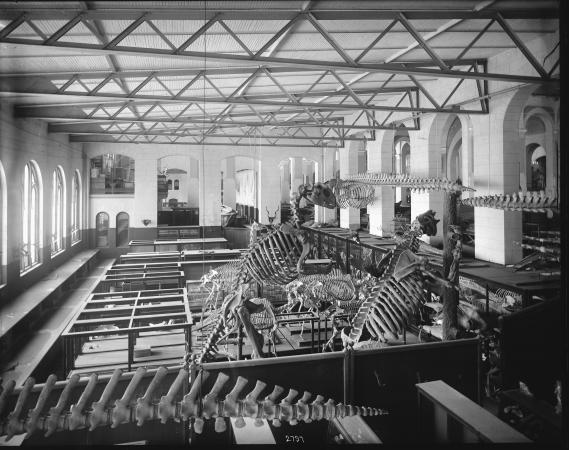
Then there is the famous (infamous?) Megatherium Club – an informal group of nineteenth- century Smithsonian naturalists who were known for working hard and playing hard. The name Megatherium refers to an extinct species of ground sloth. It is the largest sloth species ever discovered with a size equivalent to that of a modern elephant! This topic has already been extensively covered by my colleagues in past blog posts and an online exhibit, which I encourage you to check out.

Records show that the first living sloths at the National Zoo were introduced around 1900. In 1942, USNM Assistant Director A. Remington Kellogg and Smithsonian field collector Watson M. Perrygo travelled to the American Southwest to collect fossil specimens of large ground sloth species that roamed North America until about 11,000 years ago. Details of their travels and efforts are described in their field books. In a 1940 field book, sixth Secretary of the Smithsonian and ornithologist Alexander Wetmore describes excavating sloth bones in Costa Rica. In a photo album from 1963 from when he was working in Panama, Wetmore describes and includes a photograph of a two-toed sloth that decided to visit the camp site one evening!
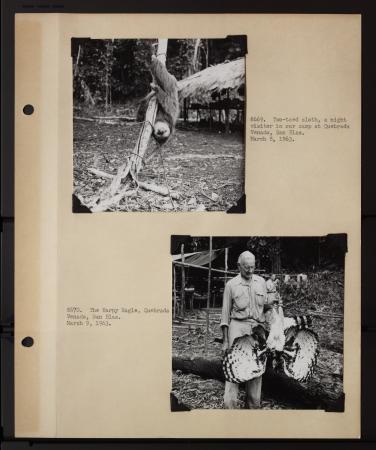
In some of our more recent collections (mid-twentieth century to present), there are many references to Smithsonian staff caring for sloths and studying and documenting their behavior. In the mid-1960s, National Zoological Park zoologist Marion P. McCrane became the first person ever to successfully hand-rear a two-toed sloth, which included having the baby sloth attached to her for long periods of time, reminiscent of the months that baby sloths remain attached to their mothers in the wild. She later published her experiences to assist those who might find themselves in a similar situation in the future. From 1971-1977, resident scientist at the Zoo John F. Eisenberg directed a long-term project on sloth research in Panama.
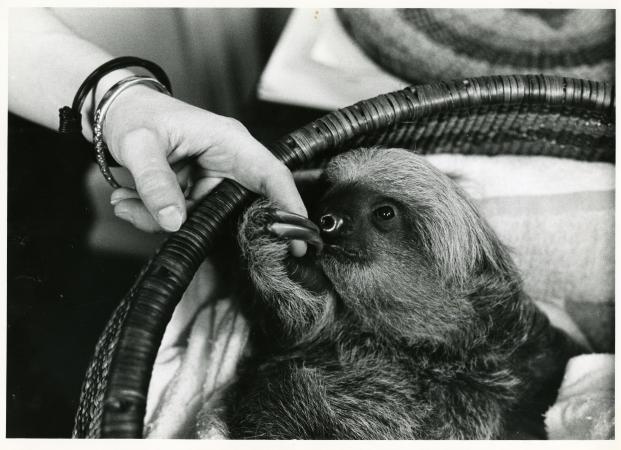
During her nearly 30-year career as a biologist with the Zoo, Dr. Devra Kleiman dedicated her professional career to researching animal behavior, most famously in her work with giant pandas and golden lion tamarins. An extensive documenter of her work in both written and audiovisual formats, Kleiman also participated in several field studies from the 1970s through the mid-2000s. Some of her field books from these trips can be viewed in the Smithsonian Transcription Center. They describe her time spent in Brazil and the Peruvian Amazon, including her observations of wild sloths, efforts to track and collar them, and collect medical information. It’s not always dry research data though—on a few occasions she describes finding sloths that had climbed their way into her bunkbed!
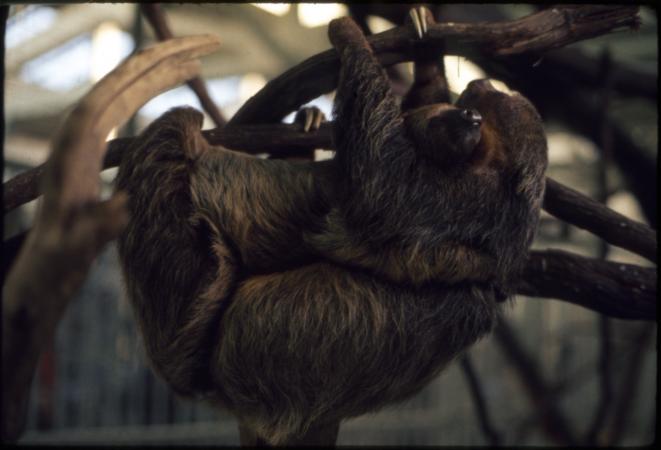
The Smithsonian Tropical Research Institute (STRI) in Panama is also very active in the scientific study of sloths, which only makes sense given its geographic location. Some of STRI’s recent topics in sloth research include the potential uses of fungi that grows on sloth hair to treat cancer and tropical diseases like malaria. Another research area is studying the symbiotic relationships between sloths and the multiple species of moths and other insects that have evolved specifically to live on sloths.
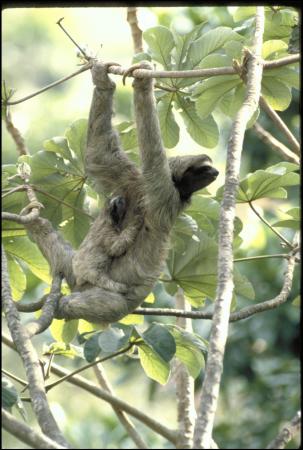
There’s still a lot we don’t know about sloths. More research remains to be done to fully understand sloths’ physiology and behavior. But at least we can say we’ve come a long way from considering them “one of the laziest of mammals,” right?
Sloths made the evolutionary decision to consume less and therefore do less, accepting all the advantages and disadvantages that came along with it. Consequently, they have carved out a niche for themselves in today’s animal kingdom, which has suited them well. I hope this has been an entertaining and educational introduction to this fascinating and unique animal!
RELATED COLLECTIONS
- Watson M. Perrygo Papers, circa 1880s-1979, Record Unit 7306, Smithsonian Institution Archives
- Smithsonian Institution, National Museum of Natural History, Department of Paleobiology Collection, Remington Kellogg field books, 1918-1942
- National Zoological Park. Department of Zoological Research, Animal Research Records, 1969-1979, Accession 08-045, Smithsonian Institution Archives
- John F. Eisenberg Papers, circa 1960-1982 and undated, Record Unit 7411, Smithsonian Institution Archives
- Marion P. McCrane Papers, 1962-1989, Accession 01-157, Smithsonian Institution Archives
- United States National Museum, Curators’ Annual Reports, 1881-1964, Record Unit 158, Smithsonian Institution Archives
RELATED RESOURCES
- “The Archival Legacy of Devra Kleiman,” by Jennifer Wright, The Bigger Picture, Smithsonian Institution Archives
- “The Megatherium Club,” Featured Topics, Smithsonian Institution Archives
- “The Mischievous Megatherium Club: After Hours,” by Candice Driver, The Bigger Picture, Smithsonian Institution Archives
- “The Substitute Mother,” by Jennifer Wright, The Bigger Picture, Smithsonian Institution Archives
Produced by the Smithsonian Institution Archives. For copyright questions, please see the Terms of Use.

Leave a Comment